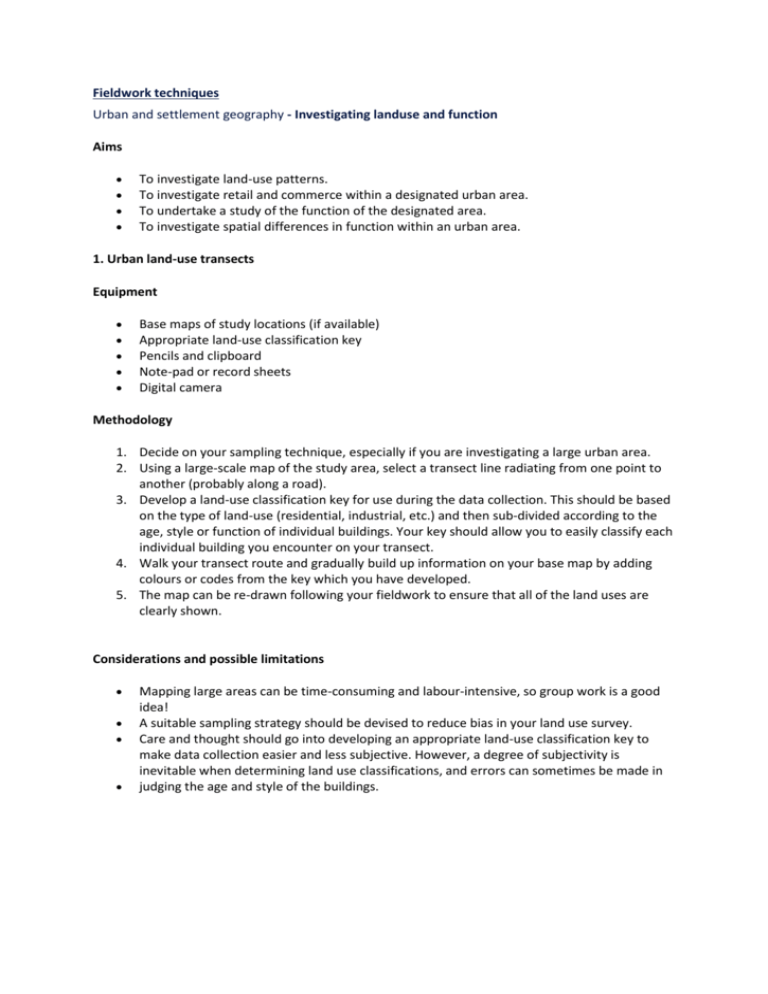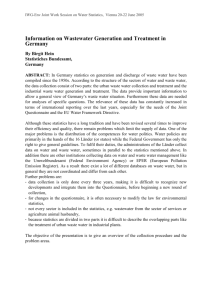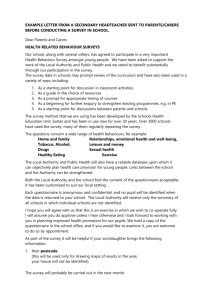Fieldwork techniques
advertisement

Fieldwork techniques Urban and settlement geography - Investigating landuse and function Aims To investigate land-use patterns. To investigate retail and commerce within a designated urban area. To undertake a study of the function of the designated area. To investigate spatial differences in function within an urban area. 1. Urban land-use transects Equipment Base maps of study locations (if available) Appropriate land-use classification key Pencils and clipboard Note-pad or record sheets Digital camera Methodology 1. Decide on your sampling technique, especially if you are investigating a large urban area. 2. Using a large-scale map of the study area, select a transect line radiating from one point to another (probably along a road). 3. Develop a land-use classification key for use during the data collection. This should be based on the type of land-use (residential, industrial, etc.) and then sub-divided according to the age, style or function of individual buildings. Your key should allow you to easily classify each individual building you encounter on your transect. 4. Walk your transect route and gradually build up information on your base map by adding colours or codes from the key which you have developed. 5. The map can be re-drawn following your fieldwork to ensure that all of the land uses are clearly shown. Considerations and possible limitations Mapping large areas can be time-consuming and labour-intensive, so group work is a good idea! A suitable sampling strategy should be devised to reduce bias in your land use survey. Care and thought should go into developing an appropriate land-use classification key to make data collection easier and less subjective. However, a degree of subjectivity is inevitable when determining land use classifications, and errors can sometimes be made in judging the age and style of the buildings. Investigating opinions - Conducting questionnaires Use within an investigation Questionnaires are a very common feature of investigations where the opinions of a group of people or different groups of people are relevant. They can be used to obtain information about the people themselves (for example a social survey to investigate the characteristics of the population being surveyed), information about patterns and processes (for example the origin of visitors to an amenity or area), or information about opinion, preferences and behaviour. Some questionnaires may involve gathering information on all of these aspects. The data collected will not be available from any other source - it is primary data unique to your investigation. Questionnaires can be used to assess the various reasons that people have decided to visit a particular area, and can include information about what activities they are doing, how far they have come from, and what method of transport they have used to get there. They should be used in conjunction with other primary and secondary data rather than in isolation. Design Think carefully about the overall aims of your investigation and how you want your questionnaires to fit in with these aims. Roughly draft some questions and play around with them until you are satisfied. The questions you design should follow some basic rules 1. Start off with a few general, easy questions to put people at ease. Ask them things like how far they have travelled, or how they have travelled. 2. Beware of personal or sensitive questions. You may want find out how old your respondents are as it may be interesting to analyse whether different age groups have different opinions. Age is tricky though - some people are sensitive about their age. The best thing to do is to use categories, e.g. under 20, 21-30, 31-40 and so on. That way, people don't have to give their exact age, and can just point to the appropriate category. 3. Names and addresses are usually not important, and aren't relevant to your study, so leave them out! 4. Don't put in embarrassing or irrelevant questions. 5. Open questions are those which don't give a choice of answers, so people are free to say what they like in response. For example, questions which ask for an opinion. 6. Closed questions are those which have a set choice of answer options for people to select from. People can still be asked for their opinion but must choose from a pre-arranged set of options. This makes it a lot easier to analyse the results. 7. Leading questions. It is easy to phrase a question so that it leads the respondent towards a certain response. For example, ‘Do you agree that graffiti is a problem in the park?' People are led towards saying yes because of the way the question is worded and phrased. This makes the results biased, and you must therefore think carefully about how you phrase questions. 8. ‘Double' questions. Avoid asking ‘two in one' questions, like ‘Do you think that there should be more litter bins and dog-waste bins in the park?' What about the person who doesn't own a dog and isn't bothered about dog-waste bins, but does think there is a litter problem? Similarly, avoid double negatives in your questions. 9. Keep your questionnaire simple: short and clear questions without ambiguity. There are a variety of ways in which the person can mark their choices on a questionnaire circling, ticking, and ranking. Think about the best method to use for each question; a mixture may make the questionnaire more interesting. Think about the length of the questionnaire and the sample size and make-up... Length - You need to find out certain things, but a clear, well-designed questionnaire with unambiguous (mostly) closed questions shouldn't take up too much of peoples' time. Aim to get what you need to know in no more than 10 questions and try to keep it to one side of A4 if possible. Sample size - Too few respondents and your questionnaire won't be representative, too many and it's unrealistic. Try to strike a balance - aim for a 10% sample of the population. The make-up of the sample is an important consideration too. A sampling strategy will need to be identified based on systematic, random or even stratified sampling (if the composition of the population is known and you are interested in examining the results by age or gender). Method of delivery - Is the questionnaire going to be face-to-face or leave and collect? Pilot study - Once you've designed your questionnaire, carry out a pilot study. Ask respondents to tell you if any questions are unclear, leading or biased, sensitive, or if you've missed anything. Think about how easy it will be for you to analyse the results. Make any changes you need before you undertake the real investigation. Carrying out your questionnaire survey Start each questionnaire by introducing yourself, saying where you're from and what you are doing. Ask people politely if they could spare a few moments to answer your short questionnaire. While you're asking your questions, remember to... Listen to what they're saying! Look interested. Respond to comments and be prepared to explain questions if they don't understand. Ask for clarification if you don't understand something they've said. And finally, don't be offended or put off if people don't want to stop and answer your questionnaire - people are busy! Considerations: Limitations and validity Carrying out face-to-face questionnaires can be time consuming. ‘Questionnaire fatigue' - people are fed up with being stopped in the street. People may not be completely honest in their responses - they may be tempted to say what they think sounds good or what they think you want to hear. People may not actually know the answer to some questions, for example the distance they've travelled. The sampling strategy may be hard to decide upon and implement in practice.









